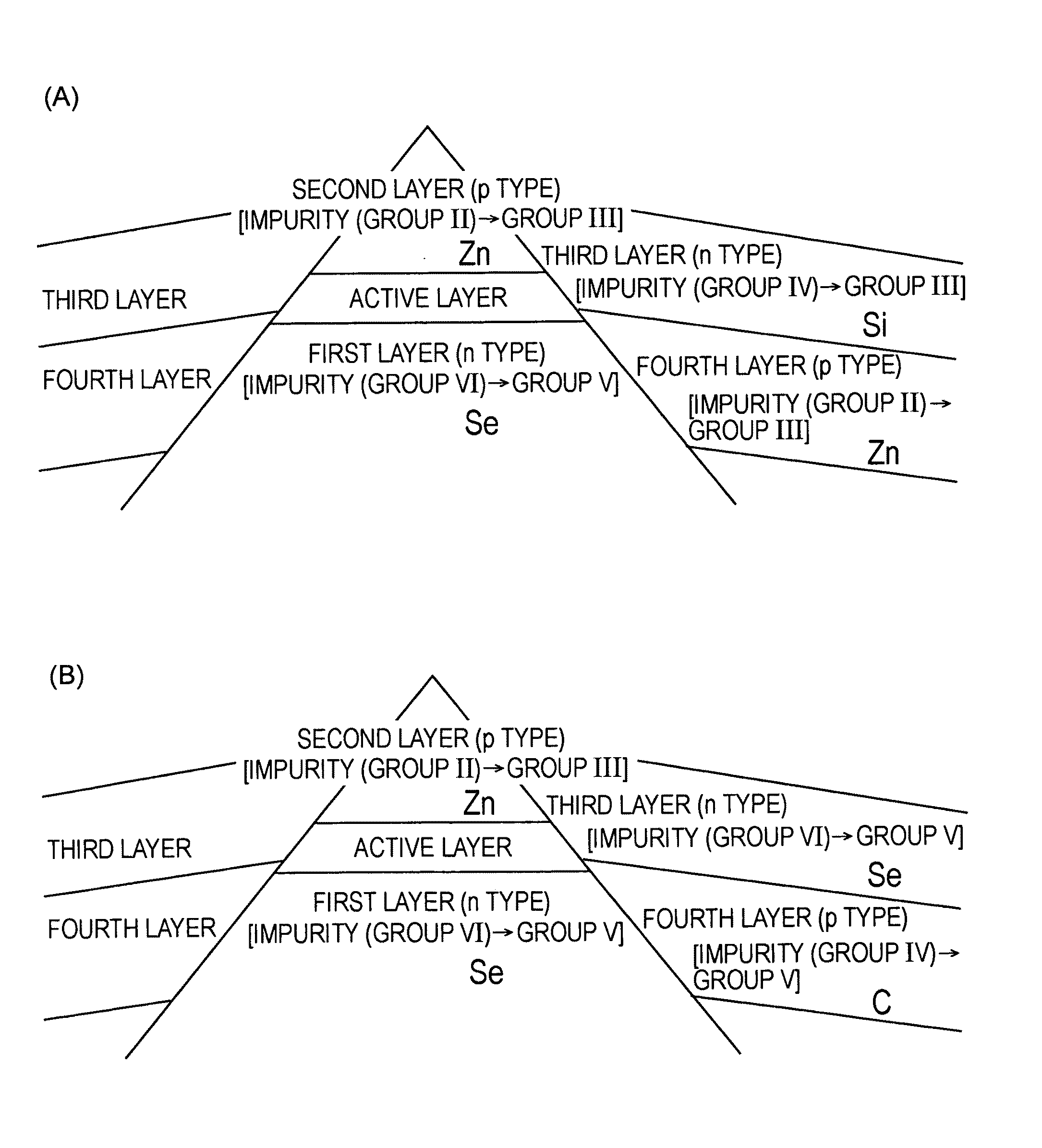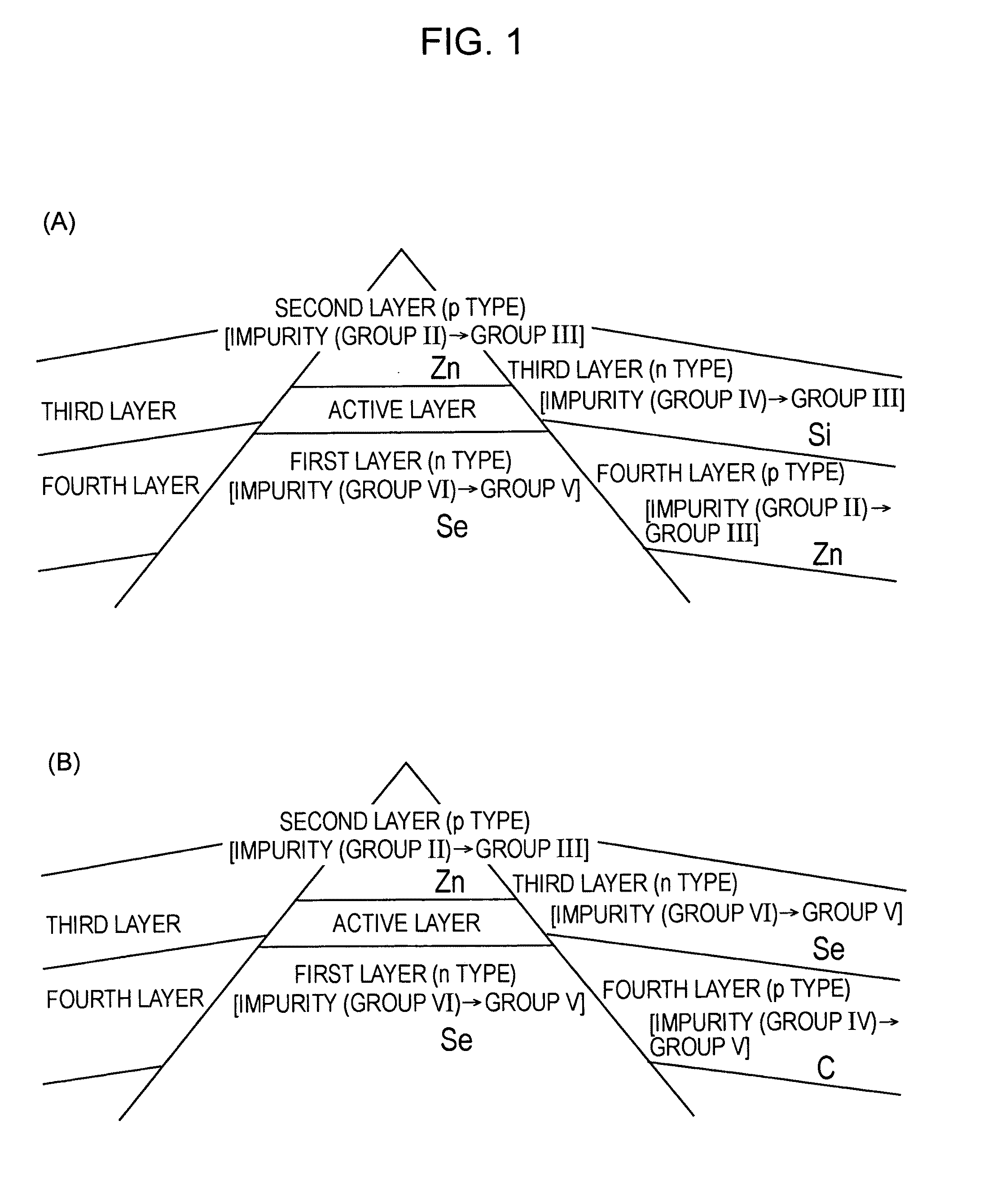Semiconductor light-emitting device
a technology of semiconductor devices and light-emitting devices, which is applied in the direction of semiconductor devices, lasers, semiconductor lasers, etc., can solve the problems putting current leakage into an nonnegligible situation, and achieve the effect of increasing current leakag
- Summary
- Abstract
- Description
- Claims
- Application Information
AI Technical Summary
Benefits of technology
Problems solved by technology
Method used
Image
Examples
example 1
[0427]Example 1 relates to semiconductor light-emitting devices according to a first embodiment of the present invention (more specifically, an embodiment 1-A-1), a second embodiment of the present invention (more specifically, an embodiment 2-A), and a fourth embodiment of the present invention.
[0428]In Example 1 or Examples 2 to 25 described below, at least one type of impurity (group VI impurity) selected from the group consisting of selenium (Se), tellurium (Te), and sulfur (S), specifically selenium (Se), is used, at least one type of impurity (group IV impurity) selected from the group consisting of silicon (Si) and tin (Sn), specifically silicon (Si), is used, and at least one type of impurity (group II impurity) selected from the group consisting of zinc (Zn), magnesium (Mg), beryllium (Be), and manganese (Mn), specifically zinc (Zn), is used. However, impurities are not limited to these.
[0429]In addition, each of the semiconductor light-emitting devices in Example 1 or Exam...
example 2
[0510]Example 2 is a modification of Example 1 and relates to an embodiment 1-B-1 of the present invention and an embodiment 2-B of the present invention.
[0511]Specifically, as shown in a conceptual view of FIG. 4(A), when a semiconductor light-emitting device of Example 2 is described with reference to the embodiment 1-B-1 of the present invention,
[0512]a first compound semiconductor layer, a second compound semiconductor layer, a third compound semiconductor layer, and a fourth compound semiconductor layer are composed of group III-V compound semiconductors,
[0513]the first compound semiconductor layer includes a first A compound semiconductor layer and a first B compound semiconductor layer provided on the first A compound semiconductor layer so as to be in contact with an active layer,
[0514]the second compound semiconductor layer includes a second B compound semiconductor layer in contact with the active layer and a second A compound semiconductor layer provided on the second B c...
example 3
[0531]Example 3 is also a modification of Example 1 and relates to an embodiment 1-C-1 of the present invention and an embodiment 2-C of the present invention and further relates to a six embodiment of the present invention. In Example 3 or Example 4 described below, the conductivity types are opposite to those in Example 1. Namely, in Example 3 or Example 4 described below, the first conductivity type is p-type, and the second conductivity type is n-type.
[0532]Specifically, as shown in a conceptual view of FIG. 7(A), a schematic partial sectional view of FIG. 29(A), and an enlarged schematic partial sectional view of FIG. 29(B), when a semiconductor light-emitting device of Example 3 is described with reference to the embodiment 1-C-1 of the present invention,
[0533]a first compound semiconductor layer 21, second compound semiconductor layers 22A and 22B, and a current-blocking layer 40 (a third compound semiconductor layer 43 and a fourth compound semiconductor layer 44) are compos...
PUM
 Login to View More
Login to View More Abstract
Description
Claims
Application Information
 Login to View More
Login to View More - R&D
- Intellectual Property
- Life Sciences
- Materials
- Tech Scout
- Unparalleled Data Quality
- Higher Quality Content
- 60% Fewer Hallucinations
Browse by: Latest US Patents, China's latest patents, Technical Efficacy Thesaurus, Application Domain, Technology Topic, Popular Technical Reports.
© 2025 PatSnap. All rights reserved.Legal|Privacy policy|Modern Slavery Act Transparency Statement|Sitemap|About US| Contact US: help@patsnap.com



